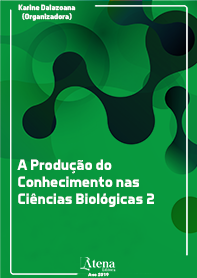
AVALIAÇÃO DO CRESCIMENTO RADICULAR DA LEGUMINOSA Canavalia ensiformis L. CULTIVADA EM SOLOS CONTAMINADOS POR MEDICAMENTOS
Riscos ambientais decorrentes do descarte inadequado de medicamentos têm aumentado com o crescimento da população (MEDINA, 2015). Objetivou-se avaliar alterações morfológicas e no crescimento na raiz da leguminosa feijão-de-porco (Canavalia ensiformes L.), cultivada em solos contaminados com resíduos de medicamentos. A pesquisa foi experimental de caráter quanti-qualitativo. Utilizou-se solo nativo e medicamentos íntegros na presença da leguminosa feijãode-porco para os tratamentos: dipirona sódica, paracetamol, gripeol®, amoxicilina, nimesulida, mistura de todas as classes medicamentosas e controle, totalizando 21 amostras com três repetições. Limitou-se a 2500mg o valor máximo de medicamento por vaso, juntamente com 04 sementes de feijão-de-porco. Desmontou-se o experimento após o ciclo vegetativo da planta, com 70 dias. Os dados obtidos tiveram suas médias comparadas pelo teste de Scott Knott a 5% de probabilidade. Não houve diferenças estatísticas significativas para o comprimento de raiz das plantas nos diferentes tratamentos e controle. Contudo, o solo com paracetamol induziu maior crescimento, 43,5 cm, ou seja, 26,8% a mais quando comparado ao controle com 34,3 cm. Justificando-se pela presença do não metal nitrogênio (N) em sua composição química, que possui alta capacidade de fixação biológica (EMBRAPA, 2000). O menor crescimento foi no tratamento com amoxicilina, 29,4 cm, 14,3% a menos em relação ao tratamento controle. Essa atrofia justifica-se pela absorção do não metal enxofre (S) presente no medicamento, inibindo seu crescimento (SZABO; et al., 2003). Conclui-se que mesmo não havendo diferenças estatísticas significativas, os medicamentos foram responsáveis por modificações no crescimento das raízes da Canavalia ensiformis L. caracterizando seu potencial fitoextrator para medicamentos.
AVALIAÇÃO DO CRESCIMENTO RADICULAR DA LEGUMINOSA Canavalia ensiformis L. CULTIVADA EM SOLOS CONTAMINADOS POR MEDICAMENTOS
-
DOI: 10.22533/at.ed.3861923092
-
Palavras-chave: poluentes do solo, remediação ambiental, feijão-de-porco, paracetamol, crescimento vegetativo.
-
Keywords: soil pollutants, environmental remediation, pig bean, paracetamol, vegetative growth.
-
Abstract:
Environmental hazards arising from the improper disposal of medicines have increased with the growth of population (MEDINA, 2015). The aim was to evaluate morphological changes and growth in the legume root hog-bean (Canavalia ensiformes l.), cultivated in soils contaminated with residues of medicines. The experimental research of quantitative and qualitative character. Using native soil and medicines of integrity in the presence of the pig bean legume for the treatments: metamizole sodium, paracetamol, gripeol®, amoxicillin, nimesulide, mixture of all classes and drug control, totaling 21 samples with three repetitions. Was limited to the maximum amount of medicine than 2500 mg per pot, along with bean seeds 04-pig. Took it apart if the experiment after the vegetative cycle of the plant, with 70 days. The data obtained had their averages compared by Scott Knott test at 5% probability. There were no statistically significant differences for the length of the root of plants in different treatments and control. However, the soil with acetaminophen induced further growth, 43.5 cm, i.e., 26.8% more when compared to the control with 34.3 cm. Justification for the presence of metal not nitrogen (N) in your chemical composition, with high capacity biological fixation ( EMBRAPA, 2000). The lower growth was in the treatment with amoxicillin, 29.4 cm, 14.3% less compared to the control treatment. This atrophy is justified by the absorption of the metal not sulphur (S) present in the medicine, inhibiting your growth (SZABO; et al., 2003). It is concluded that even with no statistically significant differences, the medicines were responsible for changes in growth of roots of Canavalia ensiformis L. featuring your fitoextrator for potential medicines.
-
Número de páginas: 15
- Juliana do Nascimento Gomides
- Maise Menezes dos Santos Souza


